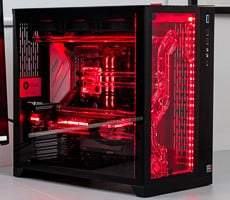Before jumping into our gauntlet of benchmarks, we applied the latest Windows software and driver updates to the Predator Helios 300. Other than that, we didn't change any settings. Our goal is to test the system as it ships, but after auto-updating, to accurately reflect what buyers can expect from an out-of-box experience. Our benchmarking kicks off with storage, CPU, and GPU tests to get an idea how the Predator Helios 300 performs in day-to-day tasks.
 |
ATTO Disk Benchmark
|
Peak Sequential Storage Throughput
|
|
Running ATTO allows us to gauge the speed of the storage drive in the Predator Helios 300. The primary storage on this particular configuration is a 256GB M.2 PCIe solid state drive, and specifically an
Intel SSD 600P.
The Intel SSD 600P is not the fastest drive out there, but even so, it still tops every SATA drive in write performance, and outright smokes them in reads. In ATTO, read performance peaked at around 1,575MB/s. That's around three times faster than the best performing SATA SSDs. The gap wasn't quite as large in writes, with a peak speed just shy of 608MB/s.
This is what we would call a sane or practical option on Acer's part. The Intel SSD 600P is not as sexy as some of the faster PCIe storage options out there, but is still plenty fast for a gaming PC.
 |
SunSpider JavaScript Benchmark
|
JavaScript Processing Performance
|
|
SunSpider tests JavaScript performance to provide a good idea of what to expect with web browsing. We used the default Edge browser in
Windows 10 to run the benchmark.
We continue to run SunSpider in part because we have plenty of systems to compare scores against. In this case, the Predator Helios 300 settled into the mid 70s range, putting it slightly behind several previous generation gaming notebooks.
 |
Cinebench R11.5 and R15
|
3D Rendering On The CPU And GPU
|
|
Cinebench tests the CPU and GPU independently and provides a glimpse of raw performance. The test is based on Maxon’s Cinema 4D modeling software that’s used in movie productions.
Unfazed by the slow start in SunSpider, the Predator Helios 300 picked itself up by the bootstraps and turned in better numbers in Cinebench R11.5, taking third place overall. It wasn't able to best Dell's similarly equipped G7 15 Gaming, though it only trailed by a few frames per second in the OpenGL test.
We have recently begun migrating over to the newer Cinebench R15. Unfortunately, we do not have a large collection of scores from gaming laptops, or even a small collection just yet. In lieu of those comparisons, we ran the Cinebench R15 on the Predator Helios 300 anyway and plotted the score with others that we do have, which is an assortment of ultrabooks primarily with quad-cores under their hood.
The Predator Helios 300 came out way ahead of those laptops, as we would expect from a system with a 6-core/12-thread Intel
Coffee Lake CPU inside. Compared to some recent gaming laptops, however, it fell a little behind.










